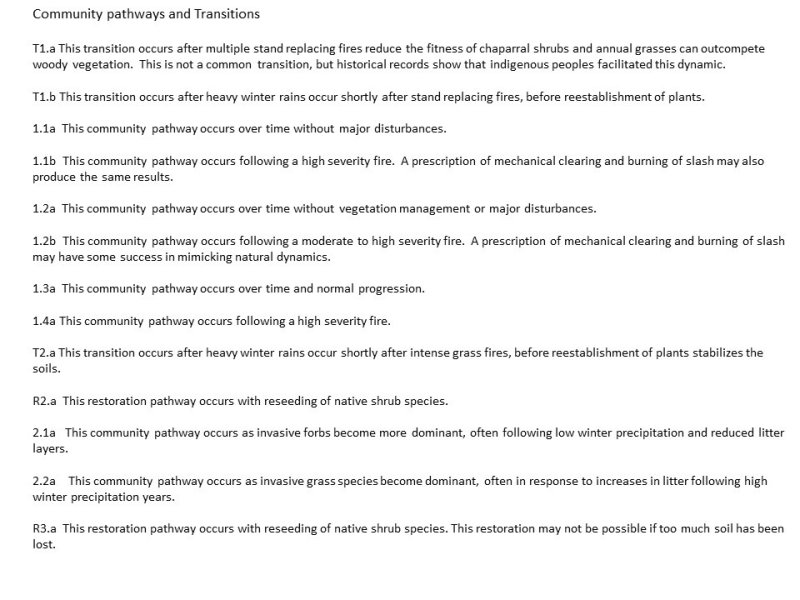
Natural Resources
Conservation Service
Ecological site R018XC107CA
Thermic Granitic Foothills south-facing
Last updated: 9/11/2024
Accessed: 04/28/2025
General information
Provisional. A provisional ecological site description has undergone quality control and quality assurance review. It contains a working state and transition model and enough information to identify the ecological site.
MLRA notes
Major Land Resource Area (MLRA): 018X–Sierra Nevada Foothills
Major Land Resource Area (MLRA): 018X–Sierra Nevada Foothills
Major Land Resource Area (MLRA) 18, Sierra Nevada Foothills is located entirely in California and runs north to south adjacent to and down-slope of the west side of the Sierra Nevada Mountains (MLRA 22A). MLRA 18 includes rolling to steep dissected hills and low mountains, with several very steep river valleys. Climate is distinctively Mediterranean (xeric soil moisture regime) with hot, dry summers, and relatively cool, wet winters. Most of the precipitation comes as rain; average annual precipitation ranges from 12 to 55 inches in most of the area (precipitation generally increases with elevation and from south to north). Geology is rather complex in this region; there were several volcanic flow and ashfall events, as well as tectonic uplift, during the past 25 million years that contributed to the current landscape.
LRU notes
LRU 18XC is located on moderate to steep mountains and hills in the Sierra Nevada Foothills east of Fresno, CA. The major differences between the southern and northern foothills are the dryer climate (12 to 37 inches of annual precipitation), greater summer/winter temperature variation, and steeper topography of the southern foothills. The geology of this region is predominately granitoid. The elevation ranges between 300 and 4100 feet above sea level. Warmer temperatures and lower precipitation (than at higher latititudes) allow for blue oak grasslands to exist at higher elevations. The soil temperature regime is primarily thermic, however some mesic soils are found at higher elevations of 18XC. At these upper elevations, the break in soil temperature regime (between thermic and mesic) is highly aspect dependent. Southern and western aspects at the steep, high elevations promote chamise-yucca plant assemblages. Buckeye is common in the concave positions. Riparian trees that are generally absent from the northern LRU’s include California Sycamore (Plantanus racemosa) and lemon scented gum (Eucalyptus citriodora).
Classification relationships
CLASSIFICATION RELATIONSHIPS
This site is located within M261F, the Sierra Nevada Foothills Section, (McNab et al., 2007) of the National Hierarchical Framework of Ecological Units (Cleland et al., 1997), M261Fc, the Lower Granitic Foothills and M261Fd, Southern Granitic Foothills Subsections.
Level III and Level IV ecoregions systems (Omernik, 1987, and EPA, 2011) are: Level III, Central California Foothills and Coastal Mountains and Level IV, Ecoregion 6c, Southern Sierran Foothills.
Ecological site concept
This site is characterized by shallow to moderately deep soils occurring on summits, shoulders, and backslopes of hills. This site occurs on metasedimentary (schist) and igneous intrusive (granitic to basic igneous) parent materials. Slopes typically range from 20 to 60%. This site occurs on south-facing slopes, where temperatures are warmer and soil conditions are drier due to a greater amount of solar radiation. Annual precipitation typically ranges from 16 to 28 inches per year. Elevation typically ranges from 1250 to 2750 feet.
The low 'effective' precipitation, due to south aspects where higher evapotranspiration demands exist, is the main limit to production. Representative moderately deep, well to somewhat excessively drained soil components include Coarsegold and Fryespoint. Coarsegold soils form on schist and are classified as fine-loamy, mixed, superactive, thermic Mollic Haploxeralfs. Fryespoint soils formed in colluvium and residuum weathered from granitic rocks and are loamy-skeletal, mixed, superactive, thermic Ultic Haploxerolls.
Vegetation communities are dominated by chamise (Adenostoma fasciculatum) stands with very little herbaceous cover. Lower densities of California yerba santa (Eriodictyon californicum) and manzanita (Arctostaphylos spp.) sometimes occur. Occasional blue oak (Quercus douglasii) and live oak (Quercus wislizeni) will occur in microsite positions that retain water for longer periods. Total annual production typically ranges from 1200 to 2600 lbs per acre.
Associated sites
| F018XC201CA |
Thermic Granitic Foothills This site commonly occurs nearby. |
|---|
Similar sites
| R018XC110CA |
Cool Thermic Shallowly Dissected Slopes Site relationships being developed. |
|---|---|
| R018XC109CA |
Steep Marble Canyon Walls Site relationships being developed. |
Table 1. Dominant plant species
| Tree |
(1) Quercus douglasii |
|---|---|
| Shrub |
(1) Adenostoma fasciculatum |
| Herbaceous |
(1) Bromus |
Click on box and path labels to scroll to the respective text.

